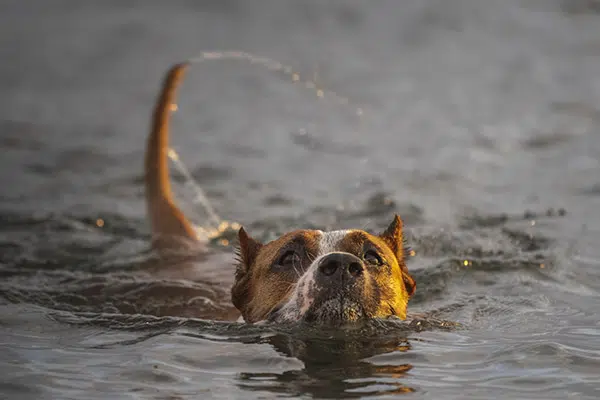If you love the water, swimming is one of those activities that you and your pup can share.
It’s a great source of exercise for both you and your pooch and will serve to keep both of you in good shape.
Swimming strengthens and tones a dog’s muscles, improves coordination and helps keep off excess weight.
If your dog has joint problems or is recuperating from an accident or surgery, swimming can be beneficial as a form of therapy.
Most importantly, swimming gives you a chance to spend quality time with your pup to strengthen your bond.
Still not convinced? Read on to see just how beneficial swimming can be for your dog.
Keeps Your Pup Healthy and Strong
Swimming is great exercise for dogs as it benefits their entire body.
Swimming works out just about every muscle group in your dog’s body to enhance his strength and agility.
If your pup is on the chunky side, swimming will increase his metabolism to help tone him down and keep him at a good weight level.
Swimming will strengthen your pup’s heart and lungs and improve his circulation, which, in turn, will promote healthy skin and fur.
Swimming stimulates your pet physically and mentally, which can help keep him at the top of his game as he grows older.
If your pup has medical issues that restrict activities like running or jogging due to a high impact on his joints, swimming is a safe alternative that will help keep him active and in shape.
A healthy dog is a happy dog that will enjoy a higher quality of life.
Gentle on the Dog’s Joints
Swimming is considered a low-impact activity that puts no pressure or stress on your pet’s joints.
The water supports your pet’s body, so there’s no direct impact on his musculoskeletal system like there is when he runs or jogs on dry land.
This makes swimming a good activity for pets with joint problems.
In fact, warm water swimming is therapeutic for dogs suffering from joint disorders or dysplasia as it helps relieve pain and fortifies their muscles and joints.
Many vets recommend swimming for dogs in rehab to help them recover from injuries or orthopedic surgery.
Swimming increases circulation to injured areas to help expedite healing.
As your pup moves differently in water than he does on land, swimming can help improve his flexibility, agility and range of motion.
Relieves Stress In Your Pup
Dogs, like people, can suffer from stress and anxiety.
Engaging your pup in water play can help relieve stress and improve his mental health.
Swimming is a fun, relaxing activity you can both enjoy.
It’s also a way of stimulating your pup’s mental abilities to help keep him sharp and alert as he grows older.
Adding swimming to your pup’s regimen gives him a break from the leash to enjoy the freedom of the water.
Your pup has a chance to release pent-up energy in the water without restraints.
You and your pup may return home bone tired, but that’s the price you pay for having fun!
You can always look forward to a good night’s sleep at day’s end!
Trims Off Excess Doggie Weight
Pet obesity has become a serious problem over the last few years.
Overeating or eating the wrong foods coupled with insufficient exercise can lead to weight problems with your dog, especially as your canine grows older.
Swimming offers a safe and practical solution to burning excess calories without putting stress on your older pet’s joints.
Dietary changes combined with swimming can help dogs lose excess weight and stay in shape as they age.
Swimming can help keep your pup active when he doesn’t have the energy for running or jogging or other strenuous activities.
It’s also a great source of exercise and play for younger pups who have lots of energy to burn so they can stay healthy and fit.
Inspires Bonding
Teaching your pup to swim gives you an opportunity to strengthen your bond of trust and love.
If you have a new pet, you can use this time to bond with your pup and establish a solid relationship you can build on.
Bonding with a new dog takes time, so don’t rush. Use this time to develop a relationship of mutual respect and trust.
The more time you spend together in the water, the easier it will become.
As your pup becomes proficient in the water, you will enjoy his company even more.
In time, swimming can become a special activity you share together and look forward to with joy.
Tips for Introducing Your Pup to the Water
Not all dogs are natural born swimmers or even have a love for the water.
You can, however, introduce your pup to the water to give him an opportunity to develop this skill.
Depending on your pup, this may take time and patience on your part.
If you love to swim and want your canine to accompany you in this sport, you’ll find ways to make it happen.
A local creek or lake, private pool or the ocean are just a few places where your pup can join you in the water.
Safety is of the utmost importance when teaching your pup to swim or introducing him to the water.
A private pool makes a good place to start as you can teach him to swim in shallow water.
Never leave your dog alone in the water and make sure he has easy access to exit points in the event he becomes scared or agitated.
You should also invest in a canine life vest to protect your pup, especially when you’re in open water like a lake or the ocean.
When it comes to summer fun in the sun with your canine companion, nothing beats a good swim!
Waterplay is a great source of fun, exercise and stimulation for dogs.

